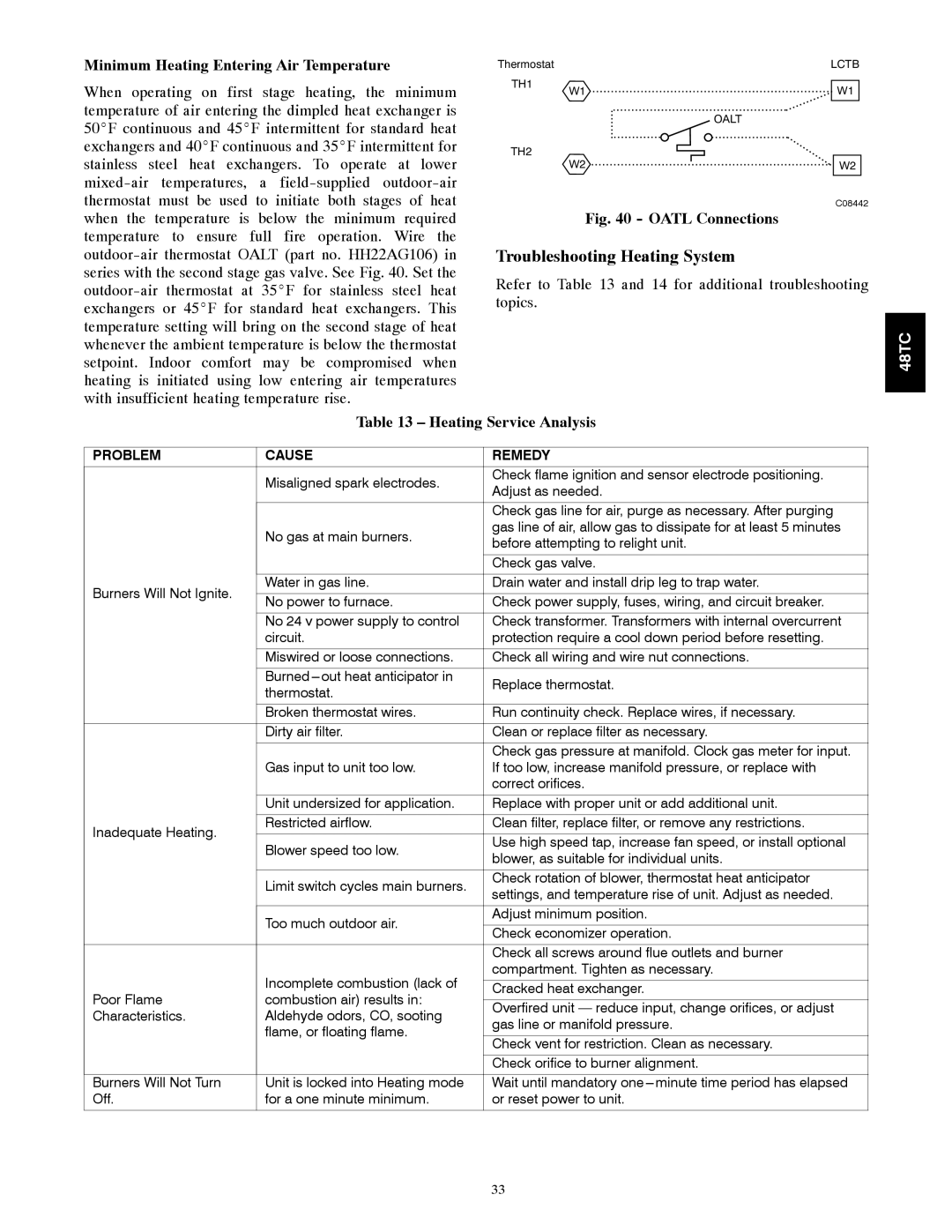
Minimum Heating Entering Air Temperature
When operating on first stage heating, the minimum temperature of air entering the dimpled heat exchanger is 50_F continuous and 45_F intermittent for standard heat exchangers and 40_F continuous and 35_F intermittent for stainless steel heat exchangers. To operate at lower
Thermostat | LCTB |
TH1 | W1 |
W1 | |
| OALT |
TH2 |
|
W2 | W2 |
C08442
Fig. 40 - OATL Connections
Troubleshooting Heating System
Refer to Table 13 and 14 for additional troubleshooting topics.
48TC
| Table 13 – Heating Service Analysis | ||
|
|
| |
PROBLEM | CAUSE | REMEDY | |
| Misaligned spark electrodes. | Check flame ignition and sensor electrode positioning. | |
| Adjust as needed. | ||
|
| ||
|
|
| |
|
| Check gas line for air, purge as necessary. After purging | |
| No gas at main burners. | gas line of air, allow gas to dissipate for at least 5 minutes | |
| before attempting to relight unit. | ||
|
| ||
|
|
| |
|
| Check gas valve. | |
Burners Will Not Ignite. | Water in gas line. | Drain water and install drip leg to trap water. | |
|
| ||
No power to furnace. | Check power supply, fuses, wiring, and circuit breaker. | ||
| |||
| No 24 v power supply to control | Check transformer. Transformers with internal overcurrent | |
| circuit. | protection require a cool down period before resetting. | |
|
|
| |
| Miswired or loose connections. | Check all wiring and wire nut connections. | |
|
|
| |
| Replace thermostat. | ||
| thermostat. | ||
|
| ||
|
|
| |
| Broken thermostat wires. | Run continuity check. Replace wires, if necessary. | |
| Dirty air filter. | Clean or replace filter as necessary. | |
|
|
| |
| Gas input to unit too low. | Check gas pressure at manifold. Clock gas meter for input. | |
| If too low, increase manifold pressure, or replace with | ||
|
| correct orifices. | |
|
|
| |
| Unit undersized for application. | Replace with proper unit or add additional unit. | |
Inadequate Heating. | Restricted airflow. | Clean filter, replace filter, or remove any restrictions. | |
|
| ||
Blower speed too low. | Use high speed tap, increase fan speed, or install optional | ||
| |||
| blower, as suitable for individual units. | ||
|
| ||
|
|
| |
| Limit switch cycles main burners. | Check rotation of blower, thermostat heat anticipator | |
| settings, and temperature rise of unit. Adjust as needed. | ||
|
| ||
|
|
| |
| Too much outdoor air. | Adjust minimum position. | |
|
| ||
| Check economizer operation. | ||
|
| ||
|
| Check all screws around flue outlets and burner | |
| Incomplete combustion (lack of | compartment. Tighten as necessary. | |
|
| ||
Poor Flame | Cracked heat exchanger. | ||
combustion air) results in: | |||
| |||
Overfired unit — reduce input, change orifices, or adjust | |||
Characteristics. | Aldehyde odors, CO, sooting | ||
gas line or manifold pressure. | |||
| flame, or floating flame. | ||
|
| ||
| Check vent for restriction. Clean as necessary. | ||
|
| ||
|
| Check orifice to burner alignment. | |
|
|
| |
Burners Will Not Turn | Unit is locked into Heating mode | Wait until mandatory | |
Off. | for a one minute minimum. | or reset power to unit. | |
|
|
| |
33
